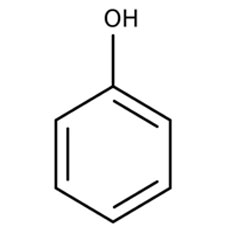 What is Phenol?
What is Phenol?
Phenol is both a manufactured chemical and a natural substance. It is a colorless-to-white solid when pure. The commercial product is a liquid. Phenol has a distinct odor that is sickeningly sweet and tarry.
Uses
The primary use of phenol is in the production of phenolic resins, which are used in the plywood, construction, automotive, and appliance industries. Phenol is also used in the production of caprolactam and bisphenol A, which are intermediates in the manufacture of nylon and epoxy resins, respectively. Other uses of phenol include as a slimicide, as a disinfectant, and in medicinal products such as ear and nose drops, throat lozenges, and mouthwashes.
Sources & Potential Exposure
Exposure to phenol may occur from the use of some medicinal products (including throat lozenges and ointments). Phenol is highly irritating to the skin, eyes, and mucous membranes in humans after acute (short-term) inhalation or dermal exposures. Phenol is considered to be quite toxic to humans via oral exposure. Anorexia, progressive weight loss, diarrhea, vertigo, salivation, a dark coloration of the urine, and blood and liver effects have been reported in chronically (long-term) exposed humans.
Animal studies have reported reduced fetal body weights, growth retardation, and abnormal development in the offspring of animals exposed to phenol by the oral route. Individuals may be exposed to phenol through breathing contaminated air or through skin contact in the workplace. Other exposures to phenol may occur through the use of phenol-containing medicinal products (including mouthwashes, toothache drops, throat lozenges, analgesic rubs, and antiseptic lotions) or smoking tobacco.
Federal Regulations
EPA has classified phenol as a Group D, not classifiable as to human carcinogenicity.

 Americas
Americas Europe
Europe Français
Français Deutsch
Deutsch Italiano
Italiano Español
Español
